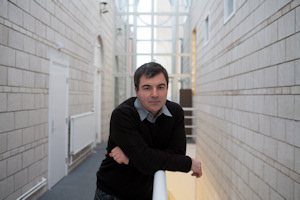Oct 20 2015
A group of UK researchers was awarded £4 million grant by the Engineering and Physical Sciences Research Council (EPSRC) to explore the unique characteristics of 2D materials. The team is being headed by Sir Kostya, Nobel laureate from the University of Manchester.
 Sir Kostya will lead some of the University's most-renowned academics.
Sir Kostya will lead some of the University's most-renowned academics.
The award is part of the £21 million grants that plan to address the critical issues in the science and engineering fields.
The latest study could help in developing designer materials that can meet today’s industry demands, and also, aid in developing devices that can possibly be used in the future. Overall, 20 universities in the UK and 80 partners will collaborate together for the study, which will be carried out in response to a call titled, ”Towards Engineering Grand Challenges: Network and Multidisciplinary Research Consortia.”
Science Minister Jo Johnson announced the new projects. He said, “As a One Nation Government we are investing in world-class science and engineering across our country. “We want the UK to be the best place in Europe to innovate and this £21 million investment will bring together the nation’s researchers to address some of the most pressing engineering challenges we face.”
Sir Kostya-headed team comprises the recently appointed Research Director of the National Graphene Institute at the University, Professor Vladimir Falko; Sir Andre Geim; Professor Brian Derby; Dr Zhirun Hu; Professor Steve Yeates; Dr Cinzia Casiraghi; and The University of Cambridge Professor Andrea Ferrari.
2D materials are single-atom-thick compounds that have a wide range of remarkable properties. Graphene is one such example of 2D materials, and is deemed to be the thinnest, strongest, and most conductive material in the world. The University of Manchester successfully separated this material in 2004.
Heterostructures refer to the combination of other 2D materials and graphene arranged in nano-stacks. With this combination, structures that are accurate and precisely modified can be developed for specific purposes.
The aim of the project is to print the materials on relatively large and complicated structures. Such materials can possibly be applied in a different scope of areas, but the electronic devices industries remain the major target, as these industries would be able to develop sensors that are both adaptable and comparatively smaller. This would ultimately lead to a nation that is well-connected via the internet of things.
Sir Kostya said: “Two-dimensional materials is a growing and fascinating area of research, and this grant will help further our understanding of how these materials function.
“Combining a range of 2D materials in heterostructures could allow us to engineer applications and products that are as yet beyond our comprehension.”
EPSRC’s Chief Executive, Professor Philip Nelson said: “Economic and political forces will shape the world of the future but these are often led and influenced by advances in science and engineering. The projects announced today will help us plan and maintain our cities, reduce our energy consumption and develop new materials, innovative devices and technology.
“The UK has world-leading academic talent to enlist in the challenges we face as a country and as a species. Investing in research is investing in the UK’s future.”